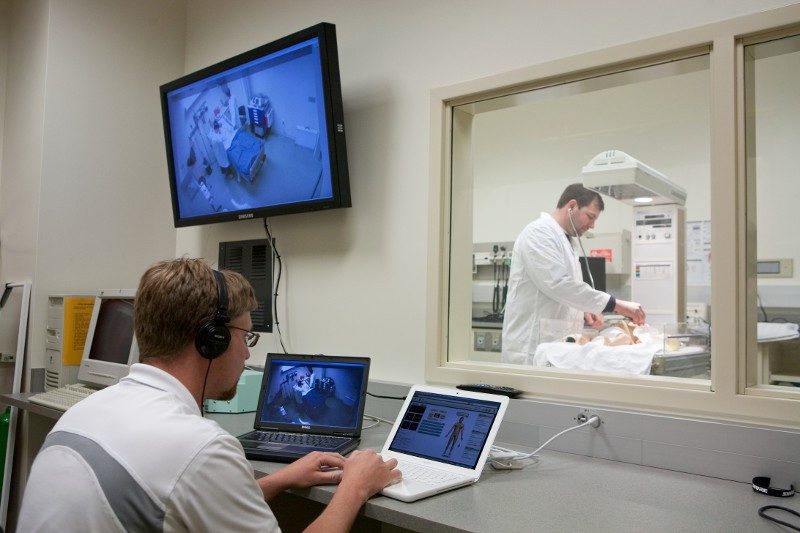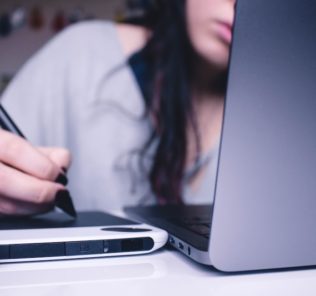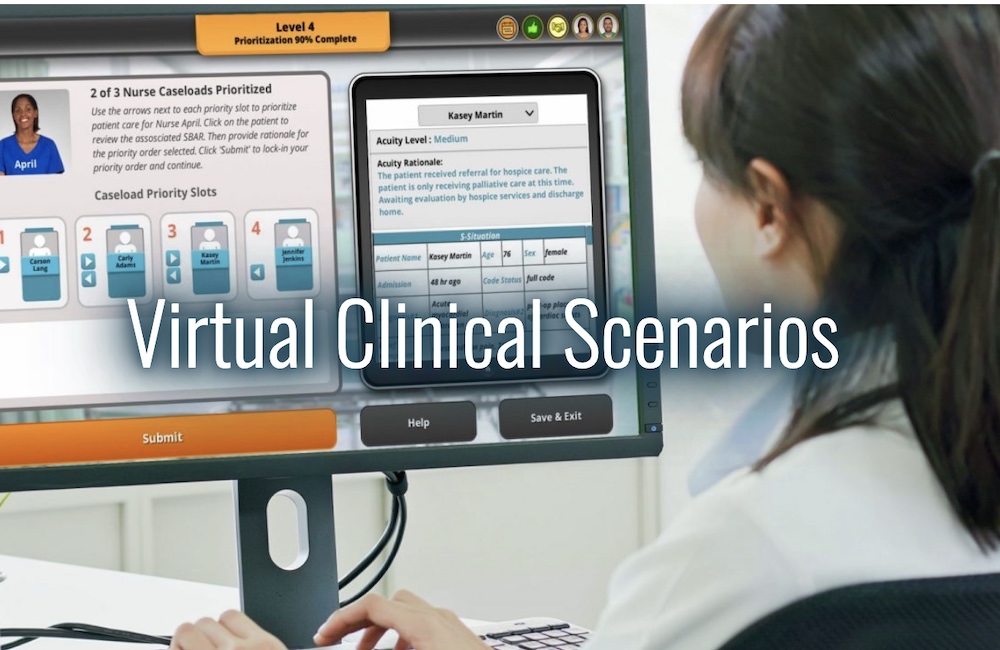Remote Standardized Patient Use During the COVID-19 Pandemic
Although there has typically been little guidance published regarding the use of remote video technology with human Standardized Patients (SP) in live encounters, the COVID-19 global pandemic provided an opportunity to explore potential benefits and challenges of this methodology. Standardized patients have been used extensively in health professions training, both for learners and in continuing education experiences for working professionals. Although virtual SPs in the form of computer-generated patient avatars have been created to standardize experiences between learners, human SPs are most commonly utilized. An SP has been defined as “an individual trained to portray a patient with a specific condition in a realistic, standardized and repeatable way and where portrayal/presentation varies based only on learner performance.” (1)
One of the benefits of including clinical simulation in the education of health professions learners is its ability to replicate real-world situations. (2) As the use of telehealth continues to expand, along with the availability of technology that supports it, it is likely that students enrolled in health professions education now will be asked to utilize telehealth at some point in their careers. (3) This reality is further reflected by the inclusion of telehealth skills in the competencies required by the accreditation bodies of many health professions, such as the Accreditation Commission for Education in Nursing and the Accreditation Council for Education in Nutrition and Dietetics. (4, 5) Therefore, the inclusion of simulations that replicate the telehealth environment is likely to continue to increase in their use and value.
Background: Remote SP learning experiences have been utilized in medical education specifically to teach telemedicine skills. (3, 6, 7) Common uses of experiential learning incorporating remote SPs are to build learners’ communication skills and confidence. (6, 7) In these scenarios, students have acknowledged that they appreciate having the opportunity to interact with human SPs (as opposed to virtual SPs) to build communication and interpersonal skills. (7)
Sponsored Content:
Medical educators and the American Telemedicine Association have noted the presence of a specific set of telemedicine skills, including the ability to optimize the use of the video technology, and have suggested that these skills be added to the education of physicians and other health professionals using this technology. (6, 7) For example, a recent study of medical residents at New York University found that during a telemedicine laboratory, just 46% of SPs rated the residents’ effective use of the video technology interface as “well done.” (3) Although telemedicine skills and potential barriers to use of required technology have been discussed in the context of medical education, little has been published about the remote use of human SPs to teach allied health professions and nursing students. (8)
Pre and De-briefing with Human SP and Learners in Remote Experiences
Best practice research in the field of simulation-based education (SBE) indicates that pre-briefing and de-briefing are essential elements in providing both a physically and psychologically safe environment and facilitating the most impactful learning experience. (2, 9) However, pre- and de-briefing guidance have been developed for in-person simulations. (9) Although self-debriefing principles have been examined for wholly virtual simulation experiences, it is not known how these key parts of the experience may differ both for faculty facilitating and for students participating in these remotely delivered SP events. (9, 10)
The current COVID-19 global pandemic and the unique capabilities of a university-based simulation center, provide an opportunity to explore the potential benefits and challenges of the use of this methodology for the instruction of allied health professions and nursing students. The results of this study could be utilized by healthcare education providers worldwide, as we adapt to the COVID-19 crisis, and prepare contingency plans for other pandemic situations which may arise in the future.
Sponsored Content:
Methods
This qualitative study utilized two online surveys, one for faculty and one for health professions students who participated in laboratories with remote technology and human SPs in the spring of 2020. The surveys were conducted using Qualtrics, which also recorded the informed consent of participants. No identifiable information was collected from any participant and the study was approved as exempt research by the Human Subjects Institutional Review Board of the university affiliated with the researchers and participants.
Participants and Materials
Participant recruitment and selection used a “gatekeeper” approach, whereby the researcher did not obtain contact information or names for any potential participants. The standardized patient program coordinator of the university’s simulation center forwarded a recruitment email to faculty from the university who had utilized remote standardized patients in a laboratory during the academic semester that included the months of March and April in 2020. The email invited faculty to participate in the faculty survey and asked them to consider passing an attached recruitment email text along to their students who had participated in the lab during the same semester.
The identity of the faculty members was not revealed to the researchers, but their disciplines were recorded by the standardized patient coordinator and these were: occupational therapy, physical therapy, social work, speech-language pathology, and nursing. The emails were sent after the conclusion of the term when final grades had already been entered and received by students, so as to avoid the potential for persuasion to participate from faculty recruiting their current students.
Data Analysis
Answers to the open-ended survey questions were analyzed separately for the faculty and student versions of the survey. Transcripts of the participant answers were downloaded from Qualtrics and uploaded into the qualitative analysis software program MaxQDA. The researchers chose qualitative content analysis to organize participant response data by first locating keywords and concepts, then applying meaningful codes and, ultimately, identifying major themes in the written responses.
Results
In total, six faculty members completed the faculty survey and 21 students completed the learner version of the survey. Four major themes were identified from qualitative content analysis of the written survey responses: two from students and two from faculty participants.
Student Themes
Results from the student participants revealed two major themes. One theme was gratitude at being able to participate in experiences with live SPs, despite the need to learn remotely and openness to practice in the telehealth format. In this theme, students acknowledged the necessity of the pivot to telehealth during their education, and also expressed understanding that the telehealth experience would benefit them in their future careers in healthcare. Another theme was added anxiety resulting from the possibility of technical failures that could affect their laboratory performance in the remote format.
Faculty Themes
Two major themes were identified from the analysis of the faculty survey responses. The first was that of equivalent experiences. Faculty members assessed the overall laboratory experience in the remotely delivered SP labs as essentially equivalent to the experience of when those same laboratories were delivered in person in previous semesters. The second identified theme from faculty was that of a faculty role shift during the remote laboratories. Faculty responses described the need to shift to a supportive role and to reassure students experiencing anxiety related to the move to remote simulation and use of the remote SP technology.
Discussion
The results of this exploratory study support the idea that remote technology can be utilized with live, human SPs to produce meaningful experiences for health professions students. The addition of technology supports to reduce student anxiety could further enhance the experience for students and faculty. Faculty and student comments consistently indicated that the overall experience provided using remote technology with standardized patients was equivalent to the face-to-face version in the most important way: meeting the learning objectives of the laboratory experience.
The finding of student openness to the telehealth experience is consistent with the findings of the other published study to date looking at student experience in a remote SP laboratory forced by the COVID-19 pandemic. (12) This study, of medical residents performing objective structured clinical examinations on SPs, also found students grateful for the opportunity to practice telehealth and eager for the opportunity to gain that experience. (12)
The main area for improvement in the conduct of remote SP laboratory experiences was in reducing the anxiety of students about the possibility of technical problems that could occur during the encounter. Simulation educators agree that a major responsibility of faculty and simulation support staff is to create a psychologically safe learning environment. (2, 8) In cases of remote SP experiences, this study suggests that educators spend time explicitly addressing student concerns about the technology and reassuring students that they will not be penalized for any such issues that may occur outside of their control. This could be incorporated into the pre-briefing process for all remote SP laboratories.
Overall, the findings of this study reflect a clear understanding on the part of health professions students and educators that telehealth services are likely to remain a permanent part of the healthcare environment. As one student wrote, “I think, even when the virus clears up, Telehealth sessions should be included in the regular curriculum. I will be putting these Telehealth experiences somewhere on my resume or bringing up these experiences in future interviews.” Some students even mentioned benefits of the remote format with human SPs over in-person SP laboratories, saying, “One area that I enjoyed was that it also allowed the SPs to write down comments to then later tell us instead of just remember what they were going to say when we were in person during the encounter.”
Lessons learned from these experiences will help to maximize the benefits of remote simulation for students now and into the future. With telehealth and remote simulation experiences likely to continue to increase, the results of this study could be utilized by healthcare education providers worldwide, as we prepare contingency plans for other pandemic situations which may occur in the future and adjust to the ever-present role of technology in healthcare.
Learn more about Remote Standardized Patient Use During the CCOVID-19 Pandemic
-
- Lopreiato JO, et al., editors. Healthcare simulation dictionary. Rockville, MD: Society for Simulation in Healthcare and the Agency for Healthcare Research and Quality 2016. https://
- INACSL Standards Committee. INACSL standards of best practice: Simulation debriefing. Clin Simul Nurs 2016;12(S): S21-S25.
- Sartori DJ, Hayes RW, Horlick M, Adams JG, Zabar SR. The TeleHealth OSCE: Preparing trainees to use telemedine as a tool for transitions of care. J Graduate Med Ed. 2020.
- Accreditation Commission for Education in Nursing, Inc. ACEN accreditation manual, 2017 standards and criteria.
- Accreditation Council for Education in Nutrition and Dietetics. 2017 Accreditation Standards for Nutrition and Dietetics Education Programs. 2017; Accessed May 7, 2021.
- Sharma R, Nachum S, Davidson KW, Nochomovitz M. It’s not just FaceTime: core competencies for the Medical Virtualist. Int J Emerg Med. 2019; 12(1): 8.
- Ben-Arieh D, Charness N, Duckett K, Krupinski E, Leistner G, Strawderman L. A concise guide for telemedicine practitioners: human factors quick guide, eye contact. American Telemedicine Association. Accessed July 15, 2021.
- Oh P, Jeon KD, Koh, MS. The effects of simulation-based learning using standardized patients in nursing students: A meta-analysis. Nurse Education Today. 2015; 35, e6–e15.
- Sawyer T, Eppich W, Brett-Fleegler M, Grant V, Cheng A. More than one way to debrief: a critical review of healthcare simulation debriefing methods. Simul Healthc. 2016;11(3):209-217.
- Cant RP, Cooper SJ. Use of simulation-based learning in undergraduate nurse education: An umbrella systematic review. Nurse Education Today. 2017; 49: 63–71.
Today’s article was guest authored by Libby MacQuillan, PhD, RDN, CHSE, Program Director, Applied Food and Nutrition program at Grand Valley State University.
Have a story to share with the global healthcare simulation community? Submit your simulation news and resources here!
Sponsored Content:



















